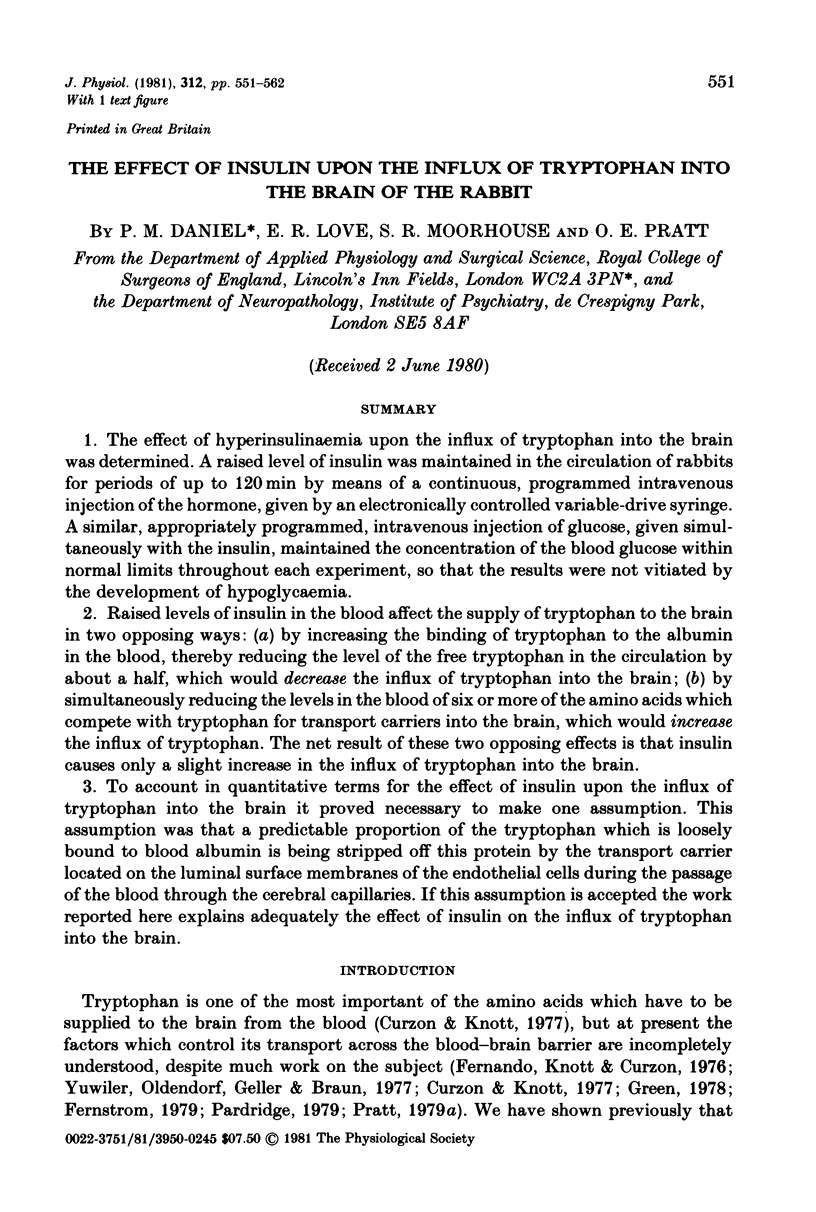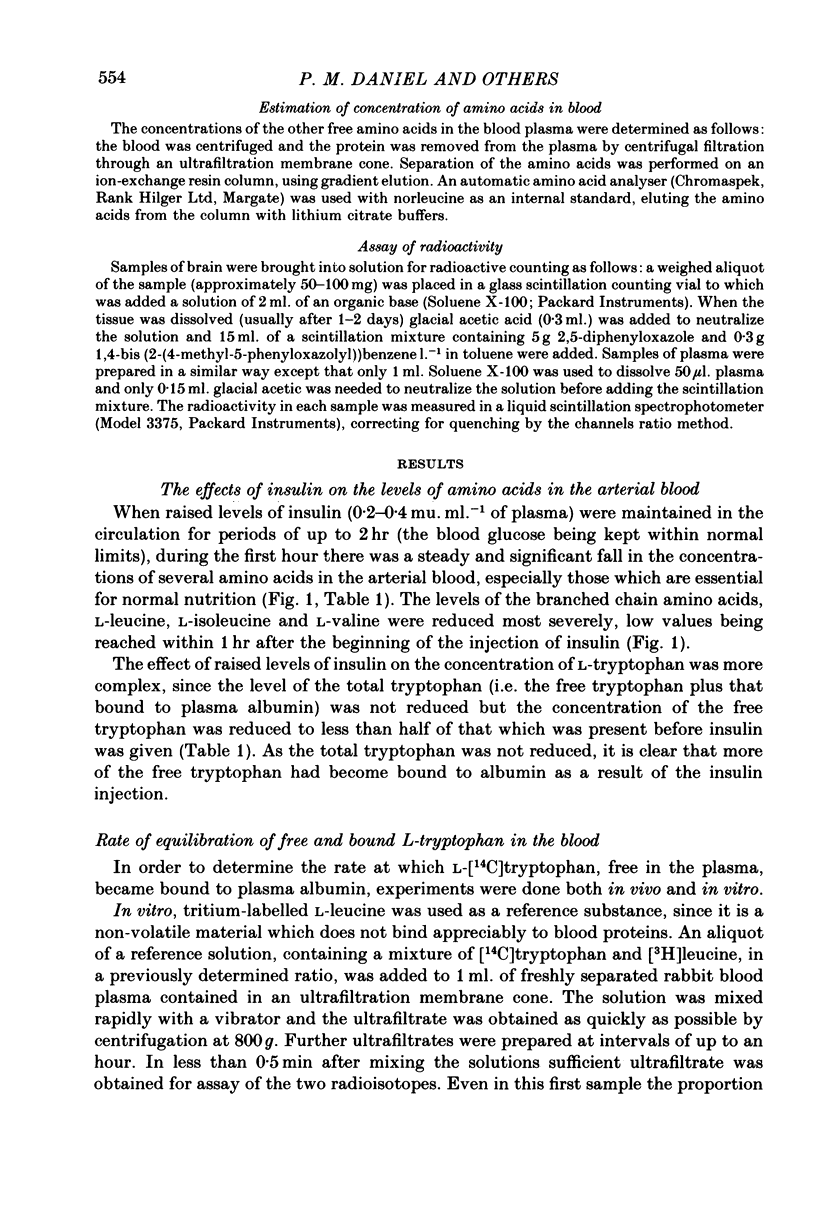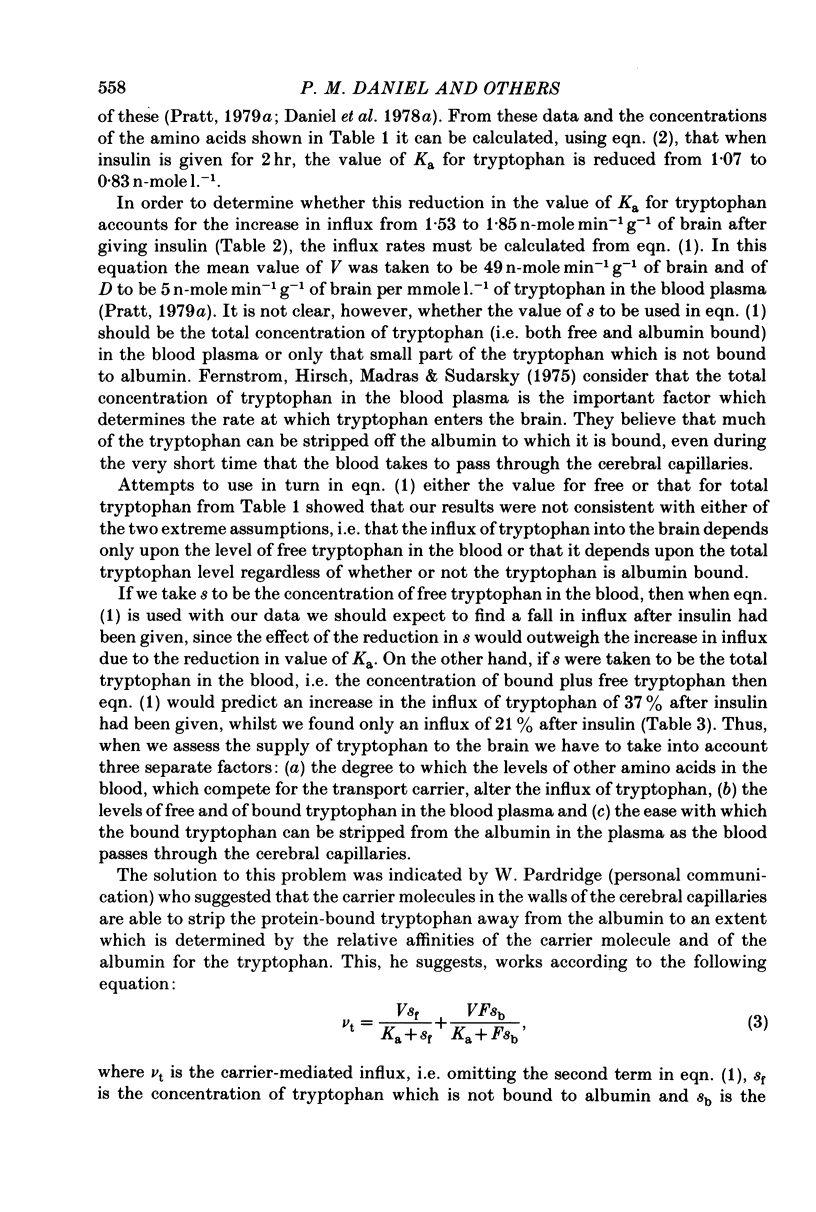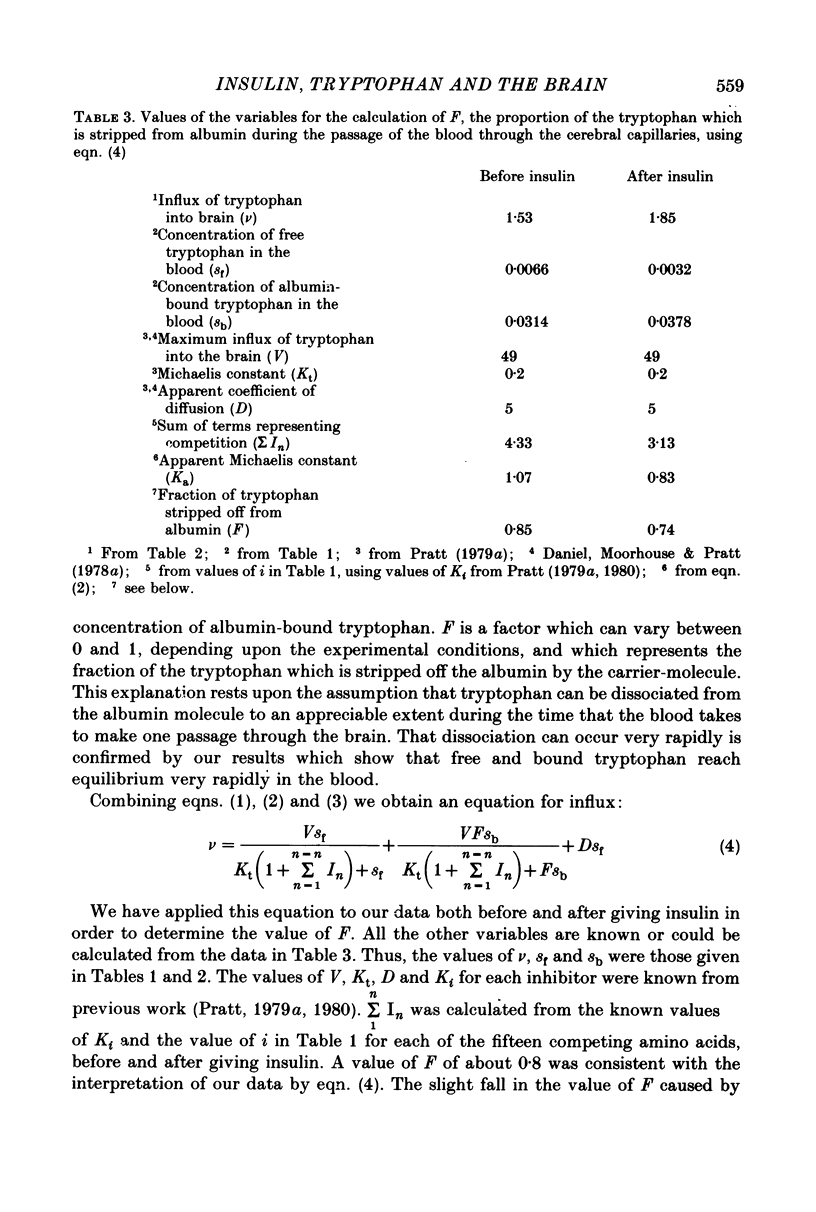Abstract
1. The effect of hyperinsulinaemia upon the influx of tryptophan into the brain was determined. A raised level of insulin was maintained in the circulation of rabbits for periods of up to 120 min by means of a continuous, programmed intravenous injection of the hormone, given by an electronically controlled variable-drive syringe. A similar, appropriately programmed, intravenous injection of glucose, given simultaneously with the insulin, maintained the concentration of the blood glucose within normal limits throughout each experiment, so that the results were not vitiated by the development of hypoglycaemia. 2. Raised levels of insulin in the blood affect the supply of tryptophan to the brain in two opposing ways: (a) by increasing the binding of tryptophan to the albumin in the blood, thereby reducing the level of the free tryptophan in the circulation by about a half, which would decrease the influx of tryptophan into the brain; (b) by simultaneously reducing the levels in the blood of six or more of the amino acids which compete with tryptophan for transport carriers into the brain, which would increase the influx of tryptophan. The net result of these two opposing effects is that insulin causes only a slight increase in the influx of tryptophan into the brain. 3. To account in quantitative terms for the effect of insulin upon the influx of tryptophan into the brain it proved necessary to make one assumption. This assumption was that a predictable proportion of the tryptophan which is loosely bound to blood albumin is being stripped off this protein by the transport carrier located on the luminal surface membranes of the endothelial cells during the passage of the blood through the cerebral capillaries. If this assumption is accepted the work reported here explains adequately the effect of insulin on the influx of tryptophan into the brain.
Full text
PDF











Selected References
These references are in PubMed. This may not be the complete list of references from this article.
- Baños G., Daniel P. M., Moorhouse S. R., Pratt O. E. The influx of amino acids into the brain of the rat in vivo: the essential compared with some non-essential amino acids. Proc R Soc Lond B Biol Sci. 1973 Feb 27;183(1070):59–70. doi: 10.1098/rspb.1973.0004. [DOI] [PubMed] [Google Scholar]
- Baños G., Daniel P. M., Moorhouse S. R., Pratt O. E. The requirements of the brain for some amino acids. J Physiol. 1975 Apr;246(3):539–548. doi: 10.1113/jphysiol.1975.sp010903. [DOI] [PMC free article] [PubMed] [Google Scholar]
- Baños G., Daniel P. M., Pratt O. E. Saturation of a shared mechanism which transports L-arginine and L-lysine into the brain of the living rat. J Physiol. 1974 Jan;236(1):29–41. doi: 10.1113/jphysiol.1974.sp010420. [DOI] [PMC free article] [PubMed] [Google Scholar]
- Bloxam D. L., Curzon G. A study of proposed determinants of brain tryptophan concentration in rats after portocaval anastomosis or sham operation. J Neurochem. 1978 Nov;31(5):1255–1263. doi: 10.1111/j.1471-4159.1978.tb06250.x. [DOI] [PubMed] [Google Scholar]
- Bloxam D. L., Warren W. H. Error in the determination of tryptophan by the method of Denkla and Dewey. A revised procedure. Anal Biochem. 1974 Aug;60(2):621–625. doi: 10.1016/0003-2697(74)90275-9. [DOI] [PubMed] [Google Scholar]
- Curzon G., Joseph M. H., Knott P. J. Effects of immobilization and food deprivation on rat brain tryptophan metabolism. J Neurochem. 1972 Aug;19(8):1967–1974. doi: 10.1111/j.1471-4159.1972.tb01486.x. [DOI] [PubMed] [Google Scholar]
- Curzon G., Knott P. J. Environmental, toxicological and related aspects of tryptophan metabolism with particular reference to the central nervous system. CRC Crit Rev Toxicol. 1977 Sep;5(2):145–187. doi: 10.3109/10408447709003378. [DOI] [PubMed] [Google Scholar]
- Curzon G., Knott P. J. Rapid effects of environmental disturbance on rat plasma unesterified fatty acid and tryptophan concentrations and their prevention by antilopolytic drugs. Br J Pharmacol. 1975 Jul;54(3):389–396. doi: 10.1111/j.1476-5381.1975.tb07580.x. [DOI] [PMC free article] [PubMed] [Google Scholar]
- Daniel P. M., Donaldson J., Pratt O. E. A method for injecting substances into the circulation to reach rapidly and to maintain a steady level. With examples of its application in the study of carbohydrate and amino acid metabolism. Med Biol Eng. 1975 Mar;13(2):214–227. doi: 10.1007/BF02477731. [DOI] [PubMed] [Google Scholar]
- Daniel P. M., Donaldson J., Pratt O. E. Infusion schedules for prescribed blood concentration time courses. J Appl Physiol. 1976 Oct;41(4):608–608. doi: 10.1152/jappl.1976.41.4.608. [DOI] [PubMed] [Google Scholar]
- Daniel P. M., Donaldson J., Pratt O. E. The rapid achievement and maintenance of a steady level of an injected substance in the blood plasma. J Physiol. 1974 Mar;237(2):8P–9P. [PubMed] [Google Scholar]
- Daniel P. M., Love E. R., Moorhouse S. R., Pratt O. E. Effect of insulin upon levels of amino acids in the blood and upon the influx of tryptophan into the brain [proceedings]. J Physiol. 1979 Apr;289:87P–88P. [PubMed] [Google Scholar]
- Daniel P. M., Love E. R., Moorhouse S. R., Pratt O. E., Wilson P. A method for rapidly washing the blood out of an organ or tissue of the anaesthetized living animal. J Physiol. 1974 Mar;237(2):11P–12P. [PubMed] [Google Scholar]
- Daniel P. M., Love E. R., Pratt O. E. Insulin and the way the brain handles glucose. J Neurochem. 1975 Oct;25(4):471–476. doi: 10.1111/j.1471-4159.1975.tb04352.x. [DOI] [PubMed] [Google Scholar]
- Daniel P. M., Love E. R., Pratt O. E. The influence of insulin upon the metabolism of glucose by the brain. Proc R Soc Lond B Biol Sci. 1977 Feb 11;196(1122):85–104. doi: 10.1098/rspb.1977.0031. [DOI] [PubMed] [Google Scholar]
- Daniel P. M., Moorhouse S. R., Pratt O. E. Amino acid precursors of monoamine neurotransmitters and some factors influencing their supply to the brain. Psychol Med. 1976 May;6(2):277–286. doi: 10.1017/s0033291700013830. [DOI] [PubMed] [Google Scholar]
- Daniel P. M., Moorhouse S. R., Pratt O. E. Post-natal changes in the transport of aromatic amino acids into the brain [proceedings]. J Physiol. 1978 Nov;284:42P–43P. [PubMed] [Google Scholar]
- De Montis M. G., Olianas M. C., Haber B., Tagliamonte A. Increase in large neutral amino acid transport into brain by insulin. J Neurochem. 1978 Jan;30(1):121–124. doi: 10.1111/j.1471-4159.1978.tb07042.x. [DOI] [PubMed] [Google Scholar]
- Denckla W. D., Dewey H. K. The determination of tryptophan in plasma, liver, and urine. J Lab Clin Med. 1967 Jan;69(1):160–169. [PubMed] [Google Scholar]
- Donaldson J., Pratt O. E. Proceedings: A method for displaying the effect of altering the constants of a function and an application to the problem of maintaining steady blood concentrations. J Physiol. 1975 Nov;252(2):5P–6P. [PubMed] [Google Scholar]
- Fernando J. C., Knott P. J., Curzon G. The relevance of both plasma free tryptophan and insulin to rat brain tryptophan concentration. J Neurochem. 1976 Jul;27(1):343–345. doi: 10.1111/j.1471-4159.1976.tb01598.x. [DOI] [PubMed] [Google Scholar]
- Fernstrom J. D. Diet-induced changes in plasma amino acid pattern: effects on the brain uptake of large neutral amino acids, and on brain serotonin synthesis. J Neural Transm Suppl. 1979;(15):55–67. doi: 10.1007/978-3-7091-2243-3_5. [DOI] [PubMed] [Google Scholar]
- Fernstrom J. D., Hirsch M. J., Madras B. K., Sudarsky L. Effects of skim milk, whole milk and light cream on serum tryptophan binding and brain tryptophan concentrations in rats. J Nutr. 1975 Oct;105(10):1359–1362. doi: 10.1093/jn/105.10.1359. [DOI] [PubMed] [Google Scholar]
- Green A. R. The effects of dietary tryptophan and its peripheral metabolism on brain-5-hydroxytryptamine synthesis and function. Essays Neurochem Neuropharmacol. 1978;3:103–127. [PubMed] [Google Scholar]
- MCMENAMY R. H., LUND C. C., VAN MARCKE J., ONCLEY J. L. The binding of L-tryptophan in human plasma at 37 degrees C. Arch Biochem Biophys. 1961 Apr;93:135–139. doi: 10.1016/0003-9861(61)90325-3. [DOI] [PubMed] [Google Scholar]
- MacKenzie R. G., Trulson M. E. Regional accumulation of tryptophan and serotonin metabolism following tryptophan loading in diabetic rats. J Neurochem. 1978 Jul;31(1):157–160. doi: 10.1111/j.1471-4159.1978.tb12443.x. [DOI] [PubMed] [Google Scholar]
- Pardridge W. M. The role of blood-brain barrier transport of tryptophan and other neutral amino acids in the regulation of substrate-limited pathways of brain amino acid metabolism. J Neural Transm Suppl. 1979;(15):43–54. doi: 10.1007/978-3-7091-2243-3_4. [DOI] [PubMed] [Google Scholar]
- Pratt O. E. A new approach to the treatment of phenylketonuria. J Ment Defic Res. 1980 Sep;24(3):203–217. doi: 10.1111/j.1365-2788.1980.tb00074.x. [DOI] [PubMed] [Google Scholar]
- Pratt O. E. An electronically controlled syringe drive for giving an injection at a variable rate according to a preset programme. J Physiol. 1974 Mar;237(2):5P–6P. [PubMed] [Google Scholar]
- Yuwiler A., Oldendorf W. H., Geller E., Braun L. Effect of albumin binding and amino acid competition on tryptophan uptake into brain. J Neurochem. 1977 May;28(5):1015–1023. doi: 10.1111/j.1471-4159.1977.tb10664.x. [DOI] [PubMed] [Google Scholar]


